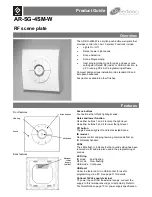UM10462
All information provided in this document is subject to legal disclaimers.
© NXP B.V. 2016. All rights reserved.
User manual
Rev. 5.5 — 21 December 2016
410 of 523
NXP Semiconductors
UM10462
Chapter 20: LPC11U3x/2x/1x Flash programming firmware
20.14 IAP commands
Remark:
When using the IAP commands, configure the power profiles in Default mode.
See
.
For in application programming the IAP routine should be called with a word pointer in
register r0 pointing to memory (RAM) containing command code and parameters. The
result of the IAP command is returned in the result table pointed to by register r1. The user
can reuse the command table for result by passing the same pointer in registers r0 and r1.
The parameter table should be big enough to hold all the results in case the number of
results are more than number of parameters. Parameter passing is illustrated in the
.
The number of parameters and results vary according to the IAP command. The
maximum number of parameters is 5, passed to the "Copy RAM to FLASH" command.
The maximum number of results is 4, returned by the "ReadUID" command. The
command handler sends the status code INVALID_COMMAND when an undefined
command is received. The IAP routine resides at 0x1FFF 1FF0 location and it is thumb
code.
The IAP function could be called in the following way using C:
Define the IAP location entry point. Since the 0th bit of the IAP location is set there will be
a change to Thumb instruction set when the program counter branches to this address.
#define IAP_LOCATION 0x1fff1ff1
Define data structure or pointers to pass IAP command table and result table to the IAP
function:
unsigned int command_param[5];
unsigned int status_result[4];
or
unsigned int * command_param;
unsigned int * status_result;
command_param = (unsigned int *) 0x...
status_result =(unsigned int *) 0x...
Define pointer to function type, which takes two parameters and returns void. Note the IAP
returns the result with the base address of the table residing in R1.
typedef void (*IAP)(unsigned int [],unsigned int[]);
IAP iap_entry;
Setting the function pointer:
iap_entry=(IAP) IAP_LOCATION;
To call the IAP, use the following statement.
iap_entry (command_param,status_result);

















